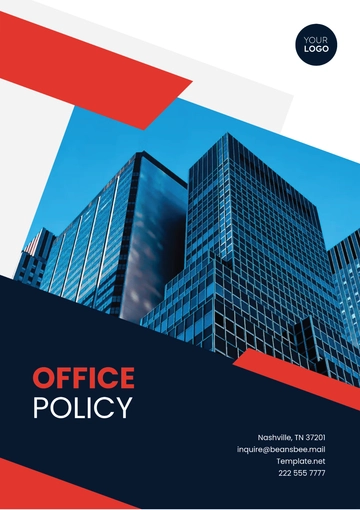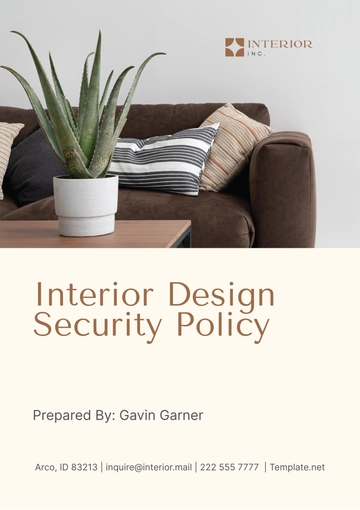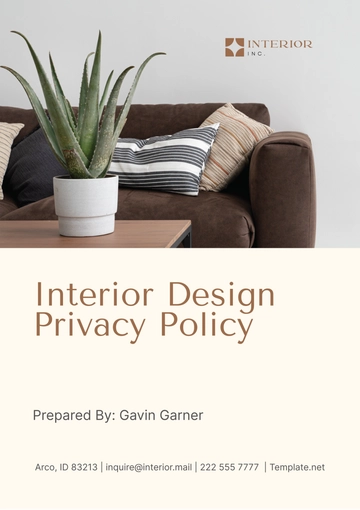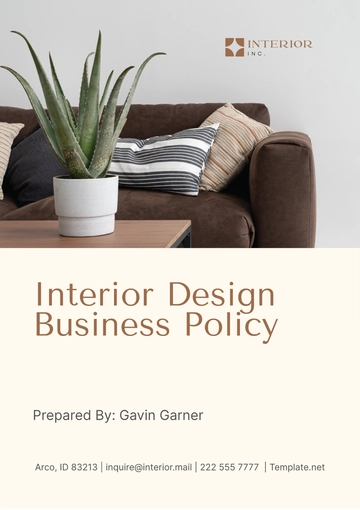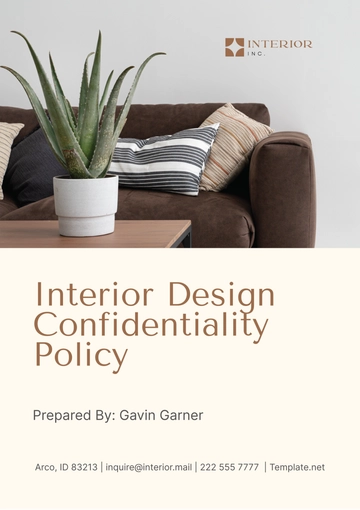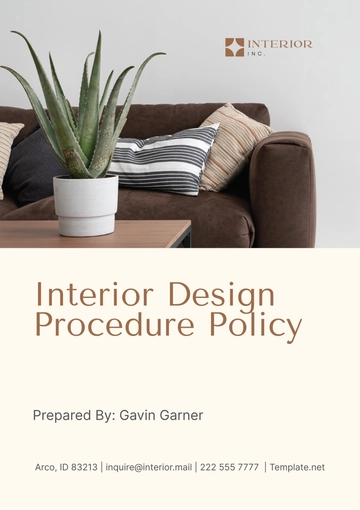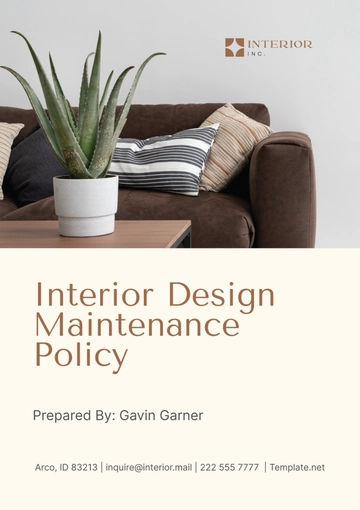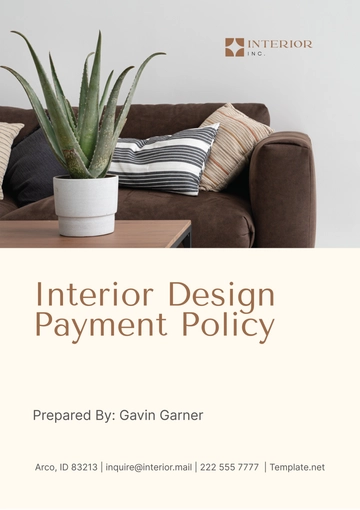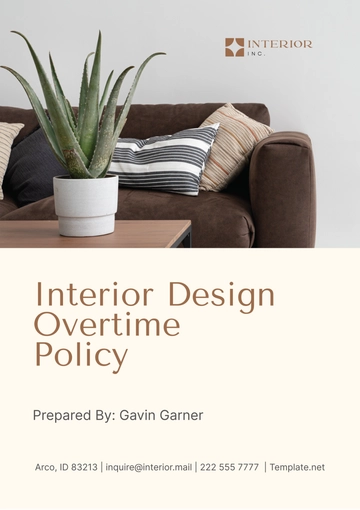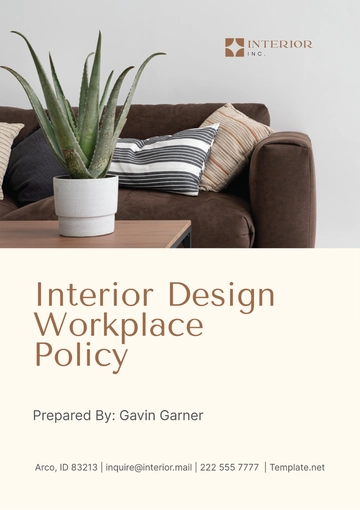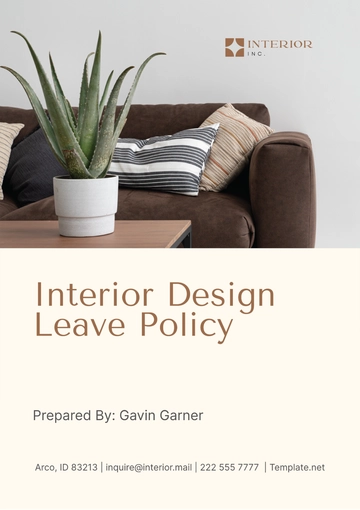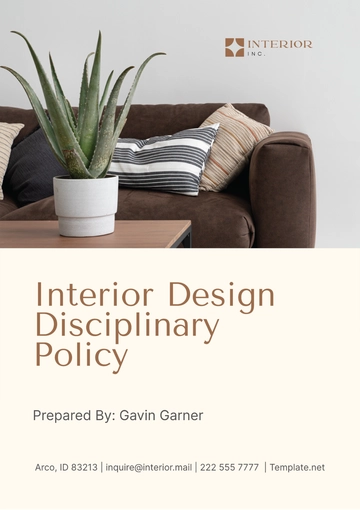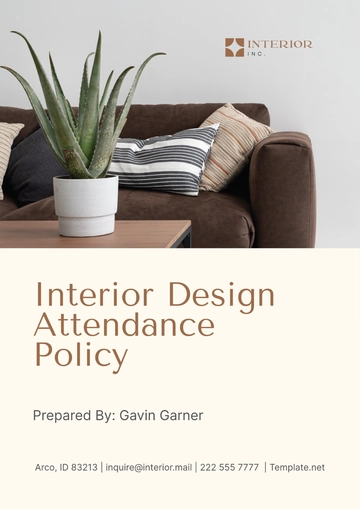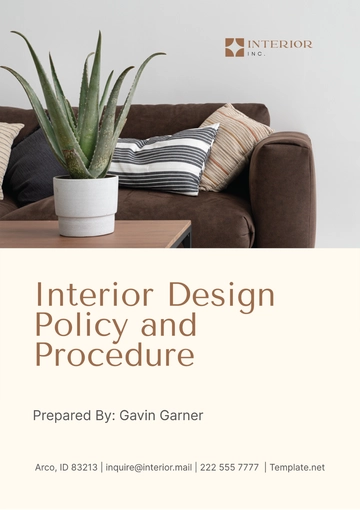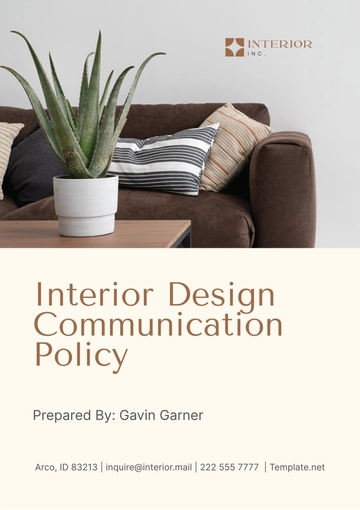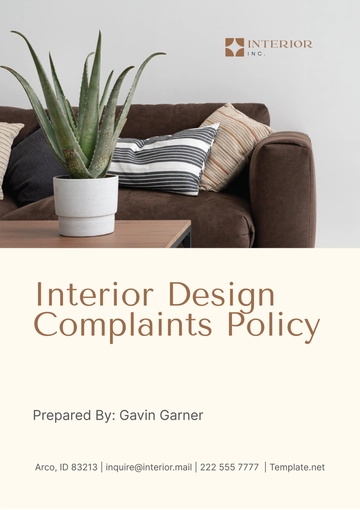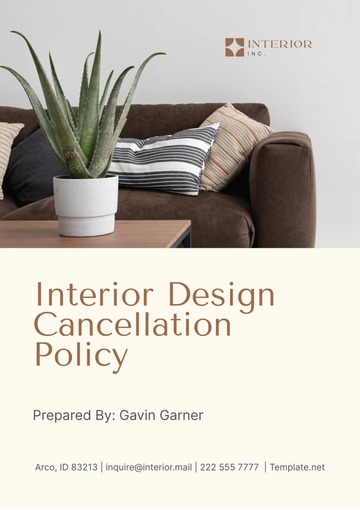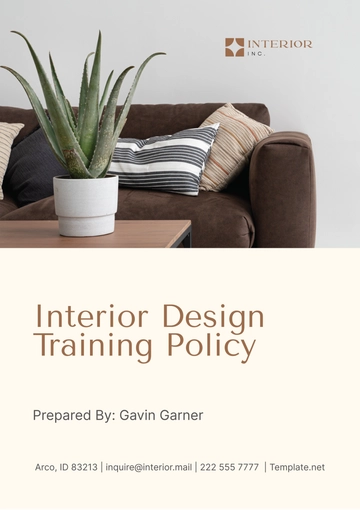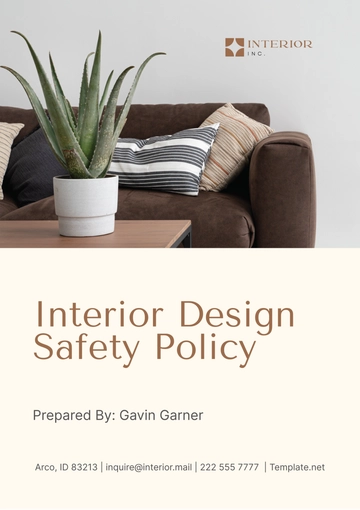Free Interior Design Workplace Policy
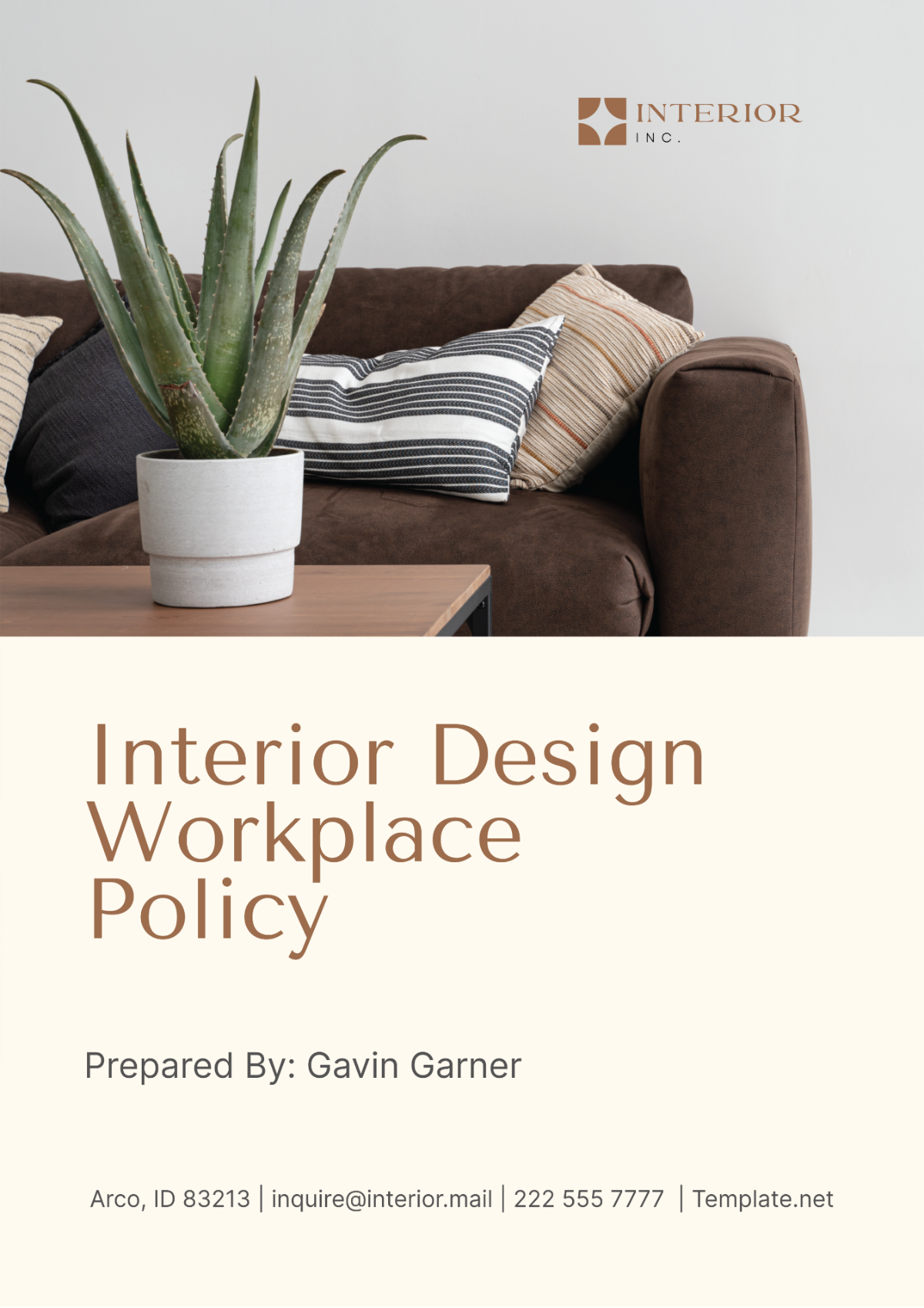
A. Code of Conduct
This Interior Design Workplace Policy, crafted for [Your Company Name], establishes foundational principles and guidelines to ensure a professional, safe, and respectful work environment. Designed specifically for the dynamic needs of the interior design industry, it aims to foster an atmosphere where creativity thrives alongside adherence to ethical standards and legal requirements.
The Code of Conduct is a cornerstone of the Interior Design Workplace Policy at [Your Company Name]. It articulates the ethical standards and professional behaviors expected of all employees. This section is vital for maintaining a collaborative, respectful, and client-focused culture within our firm.
At [Your Company Name], we commit to the highest standards of professional conduct and integrity. Employees are expected to treat each other with respect and kindness, fostering an inclusive and supportive workplace. This extends to all interactions with clients, suppliers, and partners, where professionalism is paramount.
Respect and Civility: All employees should conduct themselves in a manner that promotes cooperation and mutual respect. Bullying, harassment, and any form of discrimination are strictly prohibited. Concerns should be addressed promptly and discreetly to Human Resources.
Professional Integrity: Employees must ensure that their actions comply with legal standards and company ethics. This includes honest communication, accurate reporting, and responsible management of [Your Company Name] resources. Conflicts of interest must be avoided or disclosed according to our firm's policies.
Confidentiality: Maintaining client confidentiality and safeguarding proprietary information is crucial. Employees must not disclose or misuse sensitive information obtained through their work at [Your Company Name].
Compliance with Laws: Adherence to all relevant laws and regulations governing our industry is mandatory. This includes, but is not limited to, workplace safety, employment standards, and anti-discrimination laws.
Representation of the Firm: When interacting with the public, clients, or attending industry events, employees are expected to act as ambassadors for [Your Company Name]. The image and reputation of our firm must be upheld through professional behavior and attire.
B. Health and Safety
The Health and Safety section of the Interior Design Workplace Policy at [Your Company Name] emphasizes our commitment to a secure and healthy work environment. This is particularly vital given the physical nature of interior design tasks, which can include on-site work and handling various materials, as well as the ergonomics of office environments.
Worksite Safety Protocols
On-Site Safety: Employees must adhere to all safety guidelines when on project sites, including wearing personal protective equipment (PPE) such as hard hats and safety glasses as required. Regular safety briefings and training will be provided to ensure awareness of potential hazards.
Material Handling: Proper techniques for lifting and moving heavy or cumbersome objects must be followed to prevent injuries. This includes using equipment like dollies or asking for assistance when necessary.
Ergonomics and Office Safety
Workstation Setup: Desks, chairs, and computer monitors should be arranged to promote good posture and reduce strain. Ergonomic assessments will be conducted annually to ensure that all employees have a workspace that minimizes the risk of musculoskeletal injuries.
Breaks and Stretching: Employees are encouraged to take regular breaks and perform stretching exercises to reduce the risk of repetitive strain injuries. Guidelines for effective stretches will be provided and employees are encouraged to integrate them into their daily routines.
Chemical and Allergen Awareness
Handling and Storage: Proper handling and storage procedures for paints, solvents, and other chemicals commonly used in interior design must be followed. Material Safety Data Sheets (MSDS) for all substances will be available, and training on their safe use will be provided.
Allergen Control: Efforts shall be made to minimize exposure to potential allergens like dust and mold during renovations and on construction sites. This includes maintaining clean work areas and using appropriate filtration systems.
Emergency Procedures and First Aid
Emergency Response: Emergency exits and evacuation procedures must be clearly marked and communicated to all employees. Regular drills will be conducted to ensure readiness in case of fire, earthquake, or other emergencies.
First Aid: First aid kits will be accessible throughout all office and project sites, and employees will be trained in basic first aid and CPR.
C. Dress Code
At [Your Company Name], our Dress Code Policy is designed to reflect our company's standards of professionalism while accommodating the creative and artistic expression inherent in the interior design industry. This policy provides guidelines for appropriate attire across various settings, ensuring that employees present themselves in a manner that upholds our brand's image and meets the expectations of our diverse clientele.
General Guidelines
Employees are expected to dress in a clean, professional, and suitable manner that reflects the quality and ethos of [Your Company Name]. Clothing should be well-fitting and not excessively casual, torn, or provocative.
Creative expression is encouraged; however, it should not compromise the professional appearance or be potentially offensive to colleagues and clients.
Office Environment
Standard office attire can be business casual. This includes trousers, skirts, blouses, dress shirts, and closed-toe shoes. Jeans are acceptable if they are neat and paired with professional tops.
Casual Fridays may permit more relaxed clothing, such as t-shirts and sneakers, provided they are clean and tidy.
Client Meetings and Site Visits
When visiting clients or attending site inspections, business professional attire is required. This includes suits, blazers, dresses, or a smart combination of business separates.
Safety gear such as hard hats or safety shoes must be worn as required by the site conditions, in addition to maintaining a professional appearance.
Industry Events
For conferences, seminars, and other industry events, employees should wear formal business attire or smart business casual, depending on the event's nature and the expected attire communicated beforehand.
Seasonal Adjustments
Appropriate seasonal clothing is allowed, such as lighter fabrics during the summer and appropriate layering in the winter. However, the overall professional standard must be maintained.
This Dress Code Policy ensures that all employees of [Your Company Name] present themselves in a professional, appropriate, and culturally sensitive manner that aligns with our firm’s values and the diverse settings in which they work.
D. Use of Company Property
The Use of Company Property section at [Your Company Name] outlines the responsibilities and guidelines for handling and utilizing company resources effectively and ethically. This is crucial for maintaining the integrity of our tools and equipment, which are vital to our operational success and creative output.
Technology and Equipment
Computers and Peripherals: Employees are responsible for the careful handling of computers, printers, and other peripherals. Devices should be used for professional purposes only, and personal use should be minimal and non-disruptive to work.
Software Use: Software provided by the company, including design programs, should only be used for company projects. Unauthorized copying, installation, or distribution of company-owned software is strictly prohibited.
Materials and Supplies
Handling and Conservation: Materials such as fabrics, samples, and design supplies should be used judiciously to avoid wastage. Employees should return all unused materials to their designated storage areas.
Checkout Procedures: For high-value items, a checkout system will be enforced to track usage and ensure availability for all team members.
Intellectual Property and Archives
Confidentiality and Access: Access to company archives, including digital files and design libraries, is restricted to authorized personnel only. Confidential information must not be shared outside of [Your Company Name] without explicit permission.
Creative Assets: Use of company-owned designs, images, and other creative assets must adhere to internal policies on intellectual property rights and copyright laws.
Mobile Devices and Communication Tools
Responsible Use: Company-provided mobile devices should be used primarily for work-related communications. Personal calls and messaging should be limited to breaks and non-work hours.
Data Security: Employees must ensure that all communications and data stored on company devices are secure and in compliance with our data protection policies.
E. Confidentiality and Privacy
Employees are required to treat all information about client projects, company strategies, and internal operations as confidential unless explicitly stated otherwise. Sharing or discussing this information with unauthorized individuals, either within or outside the workplace, is strictly prohibited. This includes but is not limited to client data, design concepts, pricing details, and business strategies.
Additionally, employees must adhere to all legal requirements for data protection and privacy. They should ensure that physical and digital records are securely stored and only accessible to authorized personnel. Any breaches of confidentiality or privacy must be reported immediately to management to address the issue promptly and mitigate potential impacts on the company and our clients.
F. Anti-Discrimination and Harassment
At [Your Company Name], we uphold a commitment to an inclusive and respectful workplace. This section of our policy clearly defines our stance against discrimination and harassment, ensuring all employees feel safe and valued regardless of their background.
[Your Company Name] prohibits all forms of discrimination and harassment in the workplace. This policy applies to all employees, clients, contractors, and anyone who has a business relationship with the company. Here are the key aspects of our policy:
Zero Tolerance Policy: We maintain a zero tolerance policy towards discrimination and harassment of any kind, including but not limited to, based on race, gender, sexual orientation, religion, ethnicity, disability, age, or pregnancy.
Types of Harassment
Sexual Harassment: Unwelcome sexual advances, requests for sexual favors, and other verbal or physical conduct of a sexual nature.
Verbal Harassment: Comments or jokes that are derogatory or offensive.
Physical Harassment: Unwanted physical contact or intimidating presence.
Psychological Harassment: Actions or communications that are intended to demean, humiliate, or disturb an individual.
Reporting Mechanisms
Immediate reporting to Human Resources or a designated officer is encouraged for anyone who experiences or witnesses acts of discrimination or harassment.
Confidentiality will be maintained to the fullest extent possible throughout the investigation process.
Consequences of Violations
Appropriate disciplinary actions, including termination, will be taken against any employee found to have violated this policy.
Retaliation against individuals who report harassment or discrimination is also strictly prohibited and will be met with severe penalties.
Education and Training
Regular training sessions will be conducted to educate employees about their rights and responsibilities under this policy.
New hires will receive training as part of their orientation program to ensure they understand these important standards from the start.
G. Attendance and Punctuality
Employees are expected to adhere strictly to their scheduled work hours, as timely attendance is crucial for meeting project deadlines and facilitating team coordination. Absences must be reported to a supervisor as early as possible, and proper documentation is required for sick leave or other approved leaves of absence.
Punctuality reflects professionalism and respect for the team’s time and effort. Chronic tardiness or unexplained absences will be addressed through our disciplinary procedures. Employees are encouraged to communicate proactively with their supervisors about any potential disruptions to their schedules, ensuring that project commitments and workplace responsibilities are not compromised.
- 100% Customizable, free editor
- Access 1 Million+ Templates, photo’s & graphics
- Download or share as a template
- Click and replace photos, graphics, text, backgrounds
- Resize, crop, AI write & more
- Access advanced editor
Discover Template.net's Interior Design Workplace Policy Template – your comprehensive guide to fostering a harmonious work environment in your design firm. This editable and customizable template ensures clarity and compliance with company regulations. Designed for flexibility, it's editable in our Ai Editor Tool, offering seamless customization. Set the tone for professionalism and productivity in your interior design workspace.
You may also like
- HR Policy
- Restaurant Policy
- Company Policy
- Accounting Policies and Procedures
- Website Policy
- Privacy Policy
- Safety Policy
- School Policy
- IT and Software Policy
- Law Firm Policy
- Construction Policy
- Interior Design Policy
- Travel Agency Policy
- Education Academic Policy
- Security Policy
- Real Estate Policy
- Expense Policy
- Software Policy
